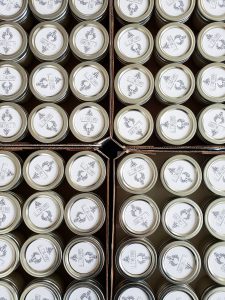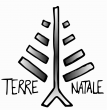
How do I use the deodorant?
What to do with hydrosols?
What to do with balms or salves?
What to do with soap bars?
What to do with liquid castile soap?
Why the ingredients list seams complicated?
What are the properties of fir essential oil?
What are the properties of cedar essential oil?
What are the properties of lavender essential oil?
What are the properties of spruce essential oil?
What are the properties of goldenrod essential oil?
What are the properties of thyme essential oil?
How do I use the deodorant?
« Le D’Sou D’Bras » must be used in small quantities (1 ml per armpit is more than enough) and preferably on clean and moist skin (right after a shower for example). If you have a sensitive skin, reduce the quantity applied and/or space out applications. If an irritation appears, cease application temporarily and then reduce the quantity applied or try another product on market that is gentler. Since it’s a natural product, the jar must always be well closed and kept in a cool and dry place between uses to keep oils fresh. The texture of the product can vary depending on the temperature. In very cold conditions, the deodorant will be firm but will melt at skin contact. Stays fresh 1 year in a cool and dry environment. The sodium bicarbonate used is 100% pure and does not therefore contain aluminum. It’s effect in this product is to make armpits less acidic to avoid the growth of bacteria responsible for bag odors.
What to do with hydrosols?
- Tonic, face wash
- Mild perfume for the body
- Add to water in a humidifier (hydrosols can be mixed directly to water contrarily to essential oils)
- Spray on clothes when ironing
- Spray on linens and clothes in drawers
- Spray on decorations or a table centerpiece
This product is NOT an air freshener or odor-eliminator. It has a delicate smell.
What to do with balms or salves?
Our salves are all purpose. They can be used for dry lips, hands, feet, backs, irritated noses during colds and flues, eczema… They can even be used for children’s irritated cheeks during winter and baby’s bottoms. Only a small quantity is necessary for an efficient hydration. It’s an all natural product, so jars must always be well closed after usage to keep oils fresh longer. Salves have a shelf-life of about 1 year when kept in a dry and cool environment.
What to do with soap bars?
Our soap bars don’t contain any artificial perfumes and are hydrating enough to use as a shampoo as well as ordinary usages for a soap bar. Sodium hydroxide, also called lye, is the active ingredient in soap making. Oils and water are transformed in glycerin and soap by lye. There is no trace of sodium hydroxide left in the final product.
What to do with liquid castile soap?
Castile soap is a natural and biodegradable soap made from vegetable oils. The most common uses are as a shampoo, shower gel and hand soap. A small amount is enough. You can also mix 1 part castile soap with 1 part water to get a softer soap (to wash your face for example). There is also a multitude of other uses: dish soap for camping, 15 ml in hot water to wash counters and floors, etc.
Why the ingredients list seams complicated?
Canadian cosmetic norms require that ingredients on body care products be written according to the International Nomenclature of Cosmetic Ingredients (INCI). Body care product labels are therefore written with technical and chemical Latin terms. It’s also possible, but not mandatory, for companies to add ingredient names in French and English. The principle is to give precise information on the content of products available on the market to consumers. Unfortunately, some ingredients can be mentioned in sub-categories like « perfume », hence hiding artificial components and other substances. At Terre Natale, we make sure our ingredients are natural, mentioned clearly in the ingredients list and written accordingly to the INCI nomenclature.
What are the properties of fir essential oil?
- Anti-inflammatory (eases stiffness, muscle aches and physical fatigue)
- Decongestant and expectorant (eases the respiratory system in case of a flu, sinusitis or bronchitis)
- Tonic
- Antiseptic
- Antispasmodic
Cease usage in case of irritations or redness, you might have an allergy to this ingredient.
What are the properties of cedar essential oil?
- Antibacterial
- Healing
- Antifungal
- Eases rheumatic and arthritic pain
Cease usage in case of irritations or redness, you might have an allergy to this ingredient.
What are the properties of lavender essential oil?
- Muscle relaxant
- Anti-inflammatory
- Antispasmodic
- Calming and soothing (eases sun burns)
Cease usage in case of irritations or redness, you might have an allergy to this ingredient.
What are the properties of spruce essential oil?
- Relaxant
- Respiratory decongestant
- Antispasmodic
- General tonic
- Anti-infectious
- Antifungal
- Pest control
Cease usage in case of irritations or redness, you might have an allergy to this ingredient.
What are the properties of goldenrod essential oil?
- Anti-inflammatory
- Calming
Cease usage in case of irritations or redness, you might have an allergy to this ingredient.
What are the properties of thyme essential oil?
- Anti-infectious
- Antiseptic
- Antibacterial
- Antifungal
Cease usage in case of irritations or redness, you might have an allergy to this ingredient.
